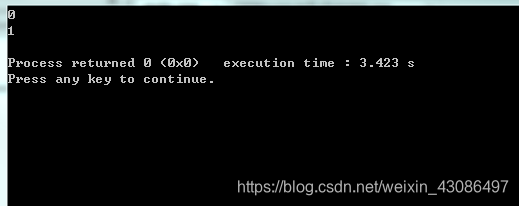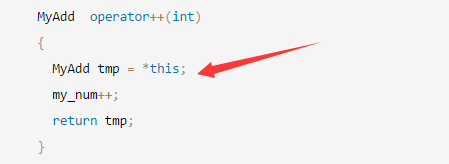前置++重载
直接上代码
#include <iostream>
#include <string>
using namespace std;
class MyAdd{
friend ostream & operator<<(ostream &cout, MyAdd a);
public:
MyAdd()
{
my_num = 0;
}
MyAdd & operator++() //返回一个对象
{
my_num++;
return *this;
}
private:
int my_num;
};
ostream & operator<<(ostream &cout, MyAdd a)
{
cout << a.my_num << endl;
return cout;
}
void example()
{
MyAdd z;
cout << ++z ;
cout << ++z ;
}
int main()
{
example();
return 0;
}
用成员函数去重载前置++运算符,并切返回值类型为类对象本身,这跟上一篇文章提到的链式变成思想有关,方便后面继续对这个对象进行操作,而不给它造成障碍。
同样是++,怎么区分前置还是后置呢,我们在后置++的重载函数中使用一个占位参数,它并不被使用,只是做区分用
代码如下:
#include <iostream>
#include <string>
using namespace std;
class MyAdd{
friend ostream & operator<<(ostream &cout, MyAdd a);//声明为友元,让它可以访问私有成员
public:
MyAdd()
{
my_num = 0;
}
MyAdd operator++(int)
{
MyAdd tmp = *this;
my_num++;
return tmp;
}
private:
int my_num;
};
ostream & operator<<(ostream &cout, MyAdd a)//重载输出运算符,方便直接输出类的对象属性
{
cout << a.my_num << endl;
return cout;
}
void example()
{
MyAdd z;
cout << z++ ;
cout << z ;
}
int main()
{
example();
return 0;
}
这里的输出结果

与前置++重载函数不同的是,这里重载函数返回的是值
为什么不返回对象本身
1、

我们这里定义的是一个局部的对象,返回局部变量操作是非法操作
2、
如果++后直接返回,那就实现不了后置++的效果,也就是实现不了执行完语句之后,对象属性再递增的效果
总结
还有其他运算符可以重载,如赋值,函数调用运算符等
对运算符进行必要的重载,可以简化很多操作,但不宜滥用
